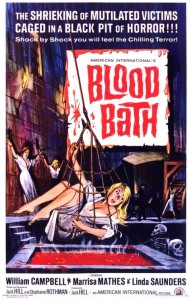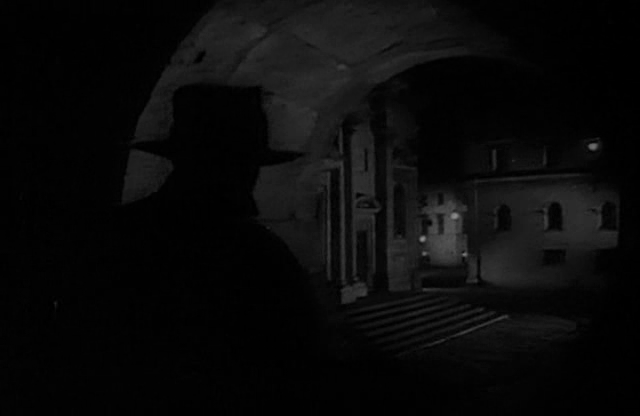“That’s the essence of what I’m after — bring death to the canvas.”
|

Synopsis:
A crazed artist (William Campbell) kills his models, painting death-themed canvases to immortalize them; meanwhile, a vampire roams the streets at night, attacking beautiful women. Could the two killers be related in some way?
|
|
Genres, Themes, Actors, and Directors:
- Artists
- Horror
- Roger Corman Films
- Stephanie Rothman Films
- Vampires
Review:
Produced by Roger Corman and co-directed by Jack Hill and Stephanie Rothman, Blood Bath (a.k.a. Track of the Vampire) is a notorious mess of a film, one which incorporates footage from an unfinished European vampire flick into an entirely different storyline about a psychopathic modern artist. (Click here to read about another such dubious “salvaged film” effort by the industrious, penny-pinching Corman.) Critics have noted Blood Bath‘s thematic parallels with Corman’s darkly humorous A Bucket of Blood (1959) — also about a crazed artist who kills for his art — but this comparison simply serves to remind one how much infinitely better the latter film is on every level. Scenes taking place in a Beatnik bar — as a cadre of wannabe artists listen intently to their mentor (Karl Schanzer) — are clearly an attempt to add some comedic relief, but ultimately fall flat. Working in Blood Bath‘s favor is its atmospheric b&w cinematography; and if one focuses exclusively on the modern-day tale of Campbell’s seduction and murder of beautiful young women, the storyline begins to makes some kind of sense (with Campbell’s visions of his ancestor seduced by a siren-like muse [Lori Saunders] simply a symptom of his deranged sensibility). Overall, however, this one remains a disappointing misfire.
Redeeming Qualities and Moments:
- Atmospheric cinematography


Must See?
No; this one is only must-see for diehard Corman fans.
Links:
|
One thought on “Blood Bath (1966)”
First viewing. A once-must, mainly for its visual design.
FFs may not ultimately find this horror flick completely satisfying, but they won’t mind checking it out once. Why? As noted in the assessment, a big plus here is DP Alfred Taylor’s surprisingly crisp and evocative b&w photography. It successfully tells a story all its own.
However, a DP is never working in a vacuum. If the story itself were dumb, the movie would still be dumb. That is not completely the case here. The viewer is called on to fill in some of the missing pieces (i.e., how the legend of the vampire remains very much a reality). But, along the way, there are some satisfying vampire riffs (i.e., attacks in a swimming pool and on a merry-go-round).
IMDb states the film is 80 minutes long – I saw a 62-minute version via Netflix, yet it seems complete (it really wouldn’t stand up well much beyond what I saw).
This is not a great movie by any means. But it still holds the viewer bizarrely fascinated. There’s a certain intelligence at work (note when the painter Max looks at a painting by a competitor painter who has used his girlfriend: “Daisy… Et tu?”). But the visuals carry the day.